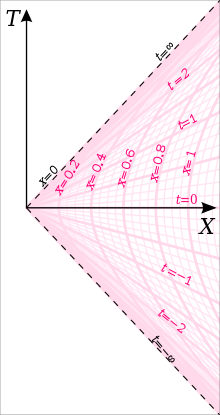润德勒坐标
相对论中,“双曲加速参考系”[H 1][1]坐标构成了平直闵可夫斯基时空中重要且有用的坐标卡系统。[2][3][4][5]狭义相对论中,一均匀加速的物体进行所谓的双曲运动;在其固有参考系中,该物体是静止的。这现象可与均匀重力场相应。关于平直时空中之加速度的一般性论述,参见狭义相对论中的加速度。
本文中,光速定义为c = 1,惯性坐标系为(X,Y,Z,T),双曲坐标系则为(x,y,z,t)。这类双曲坐标系可主要分为两大类,与加速观察者位置有关:若观察者时间T = 0时位在X = 1/α(其中α为常数值的固有加速度,由共动的加速规测得),则双曲坐标系称为“润德勒坐标”(或译林德勒坐标;英语:Rindler coordinates),与之相应的是“润德勒度规”(Rindler metric)[6]若观察者时间T = 0时位在X = 0,则双曲坐标系有时称为“穆勒坐标”(Møller coordinates)[1]或“寇特勒-穆勒坐标”(Kottler-Møller coordinates),与之相应的是“寇特勒-穆勒度规”(Kottler-Møller metric)。[7]透过采用雷达坐标[8],可得到一常与双曲运动观察者有关的替代坐标卡(Chart)。雷达坐标有时也称作“拉斯坐标”(Lass coordinates)[9][10] 寇特勒-穆勒坐标以及拉斯坐标也常标示为润德勒坐标。[11]
关于润德勒坐标的历史,这样的坐标系在狭义相对论发表不久后即被引入,在研究双曲运动此一概念的同时也被研究:与平直闵可夫斯基时空的关系如阿尔伯特·爱因斯坦(1907年,1912年)[H 2]、马克斯·玻恩(1909年)[H 1]、阿诺·索末菲(1910年)[H 3]、马克斯·冯·劳厄(1911年)[H 4]、亨德里克·洛伦兹(1913年)[H 5]、弗里德里希·寇特勒(1914年)[H 6]、沃尔夫冈·泡利(1921年)[H 7]、Karl Bollert(1922年)[H 8]、Stjepan Mohorovičić(1922年)[H 9]、乔治·勒梅特(1924年)[H 10]、爱因斯坦与纳森·罗森(1935年)[H 2]、Christian Møller(1943年,1952年)[H 11]、Fritz Rohrlich(1963年)[12]、哈利·拉斯(1963年)[13];与广义相对论中平直或弯曲时空的关联性:沃尔夫冈·润德勒(1960年,1966年)[14][15]。
润德勒参考系的特征
[编辑]
以沿-direction方向、常数值固有加速度进行双曲运动的物体,其世界线为固有时以及快度的函数,关系式为:[16]
- 。
其中为常数,为变数。这样的世界线形态为双曲线。阿诺·索末菲[H 3][17]展示了此方程组可重新表示为:为变数,而为常数;如此可表现出共动观察者所测量到双曲运动物体的“静止型态”。设定,也就是采用了观察者的固有时作为整体双曲加速参考系的时间,则惯性坐标与双曲坐标之间的转换式变为:[6][9]
逆转换式为:
各种转换式
[编辑]润德勒观察者
[编辑]参考文献
[编辑]- ^ 1.0 1.1 引用错误:没有为名为
born的参考文献提供内容 - ^ 2.0 2.1 引用错误:没有为名为
Einstein的参考文献提供内容 - ^ 3.0 3.1 引用错误:没有为名为
Sommerfeld的参考文献提供内容 - ^ 引用错误:没有为名为
Laue的参考文献提供内容 - ^ 引用错误:没有为名为
Lorentz的参考文献提供内容 - ^ 引用错误:没有为名为
Kottler的参考文献提供内容 - ^ 引用错误:没有为名为
Pauli的参考文献提供内容 - ^ 引用错误:没有为名为
Bollert的参考文献提供内容 - ^ 引用错误:没有为名为
Mohoro的参考文献提供内容 - ^ 引用错误:没有为名为
Lemaitre的参考文献提供内容 - ^ 引用错误:没有为名为
Møller的参考文献提供内容
- ^ 1.0 1.1 Øyvind Grøn. Lecture Notes on the General Theory of Relativity 772. Springer. 2010: 86–91. ISBN 0387881344.
|journal=被忽略 (帮助) - ^ Misner, C. W.; Thorne, K. S.; Wheeler, J. A. Gravitation. Freeman. 1973. ISBN 0716703440.
- ^ Kopeikin,S., Efroimsky, M., Kaplan, G. Relativistic Celestial Mechanics of the Solar System. John Wiley & Sons. 2011. ISBN 3527408568.
- ^ Padmanabhan, T. Gravitation: Foundations and Frontiers. Cambridge University Press. 2010. ISBN 1139485393.
- ^ N. D. Birrell, P. C. W. Davies. Quantum Fields in Curved Space. Cambridge University Press. 1982. ISBN 1107392810.
|journal=被忽略 (帮助) - ^ 6.0 6.1 Leonard Susskind, James Lindesay. An Introduction to Black Holes, Information and the String Theory Revolution: The Holographic Universe. World Scientific. 2005: 8-10. ISBN 9812561315.
- ^ Muñoz, Gerardo; Jones, Preston. The equivalence principle, uniformly accelerated reference frames, and the uniform gravitational field. American Journal of Physics. 2010, 78 (4): 377–383. arXiv:1003.3022
 . doi:10.1119/1.3272719.
. doi:10.1119/1.3272719.
- ^ Minguzzi, E. The Minkowski metric in non-inertial observer radar coordinates. Americam Journal of Physics. 2005, 73: 1117–1121. arXiv:physics/0412024
 . doi:10.1119/1.2060716.
. doi:10.1119/1.2060716.
- ^ 9.0 9.1 David Tilbrook. General Coordinatisations of the Flat Space-Time of Constant Proper-acceleration. Australian Journal of Physics. 1997, 50 (5): 851–868. doi:10.1071/P96111.
- ^ Jones, Preston; Wanex, Lucas F. The Clock Paradox in a Static Homogeneous Gravitational Field. Foundations of Physics Letters. 2006, 19 (1): 75–85. arXiv:physics/0604025
 . doi:10.1007/s10702-006-1850-3.
. doi:10.1007/s10702-006-1850-3.
- ^ 举例而言,Birrill & Davies (1982), pp. 110-111或Padmanabhan (2010), p. 126将方程(2g, 2h)标示为润德勒坐标或润德勒参考系;Tilbrook (1997) pp. 864-864 or Jones & Wanex (2006)将方程(2a, 2b)标示为润德勒坐标。
- ^ Rohrlich, Fritz. The principle of equivalence. Annals of Physics. 1963, 22 (2): 169–191. doi:10.1016/0003-4916(63)90051-4.
- ^ Harry Lass. Accelerating Frames of Reference and the Clock Paradox. American Journal of Physics. 1963, 31 (4): 274–276. doi:10.1119/1.1969430.
- ^ Rindler, W. Hyperbolic Motion in Curved Space Time. Physical Review. 1960, 119 (6): 2082–2089. doi:10.1103/PhysRev.119.2082.
- ^ Rindler, W. Kruskal Space and the Uniformly Accelerated Frame. American Journal of Physics. 1966, 34 (12): 1174–1178. doi:10.1119/1.1972547.
- ^ Pauli, Wolfgang, Die Relativitätstheorie, Encyclopädie der mathematischen Wissenschaften, 1921, 5 (2): 539–776
In English: Pauli, W. Theory of Relativity 165. Dover Publications. 1981 [1921]. ISBN 0-486-64152-X.|journal=被忽略 (帮助) - ^ von Laue, M. Die Relativitätstheorie, Band 1 fourth edition of "Das Relativitätsprinzip”. Vieweg. 1921.; First edition 1911, second expanded edition 1913, third expanded edition 1919.
引用错误:在<references>标签中name属性为“Møller”的参考文献没有在文中使用
引用错误:在<references>标签中name属性为“Desloge”的参考文献没有在文中使用
引用错误:在<references>标签中name属性为“Dolby”的参考文献没有在文中使用
引用错误:在<references>标签中name属性为“Pauri”的参考文献没有在文中使用
引用错误:在<references>标签中name属性为“Koks”的参考文献没有在文中使用
引用错误:在<references>标签中name属性为“Blum”的参考文献没有在文中使用














